This product arrives frozen.
Discover the rich, robust flavour of our premium mutton mince, crafted from prime cuts of mutton. This mince offers a unique depth of taste, similar to the hearty essence of beef with a subtle hint of lamb.
From our 100% grass-fed and organic rare-breed sheep, our mutton mince not only promises exceptional quality but also supports sustainable farming practices that regenerate our land and pastures.
Perfect for any dish where beef mince is traditionally used, as well as traditionally lamb or mutton dishes.
We have both 95% lean as well as 80% lean versions of this mince, if you prefer either fattier or leaner, please let us know in order notes during checkout.






Reviews
There are no reviews yet.